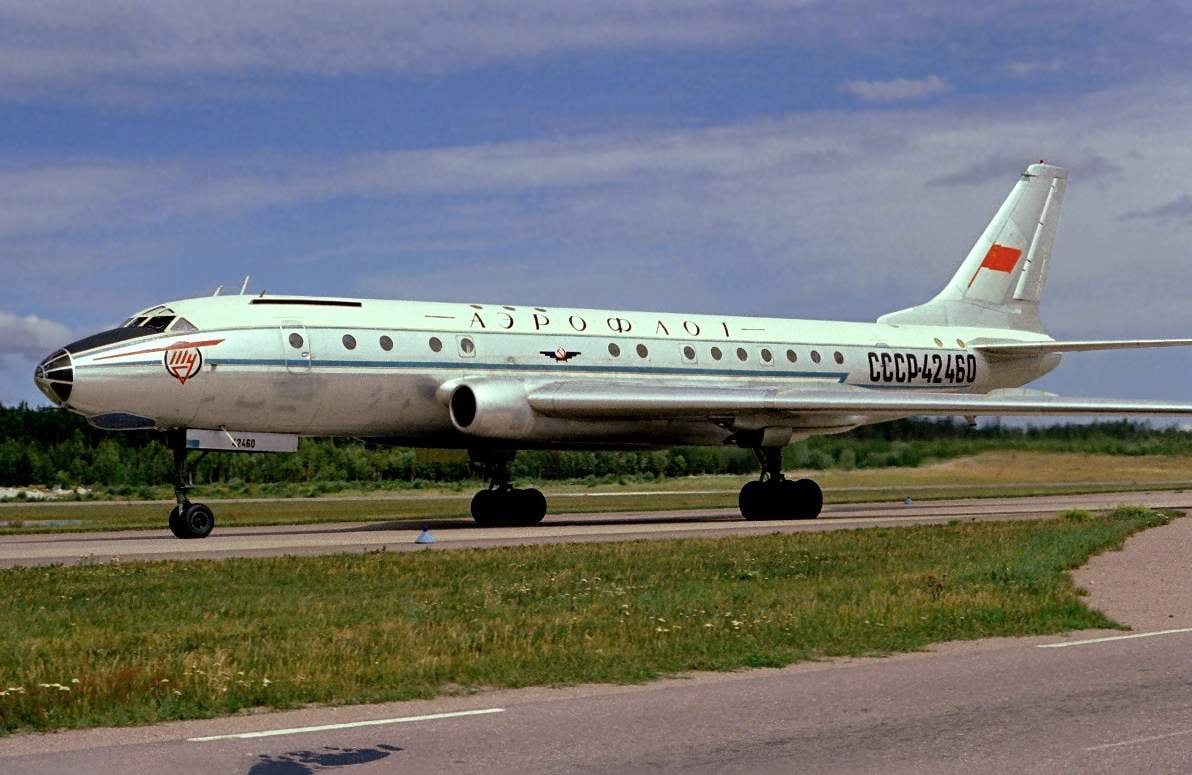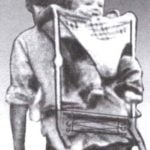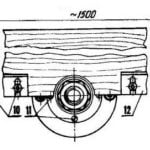 Still in the process of creating a long-range bomber Tu-16 in the brigade of General types of OKB A. N. The Tupolev appeared first outline of a passenger jet Tu-2AM-3-200. Working drawings began in 1952 — 1953, but only in June of 1954 issued a decree of the government on the development of the future Tu-104.
Still in the process of creating a long-range bomber Tu-16 in the brigade of General types of OKB A. N. The Tupolev appeared first outline of a passenger jet Tu-2AM-3-200. Working drawings began in 1952 — 1953, but only in June of 1954 issued a decree of the government on the development of the future Tu-104.
In accordance with the requirements the aircraft had to carry 50 passengers for a distance of 3,200 — 3,500 km flying at a speed of 950 — 1000 km/h during the takeoff run no more than 1600 — 1650 meters.
The design Bureau has become a tradition to develop a new passenger aircraft, using tested units, units, power units and equipment and their predecessors — bombers. This approach has significantly reduced the cycle of creating new machines, although in this case it was difficult to achieve higher performance.
Tu-16 Tu-104 borrowed the layout of the crew cabin, wing, empennage, landing gear, causing the Parking height of the plane was pretty big. But decreased the probability of falling into the engines of foreign objects, especially when operating from unpaved runways (runway). New was the fuselage and the air intake device.
On June 17, 1955, the crew of the U. T. Alasheyev made its first flight on the Tu-104, and in October started the state tests of the aircraft. In the act on the results, it was noted, in particular, that the Tu-104 flying qualities available to pilots of average qualification, but requires aerodromes with a runway length of at least 2500 m, and in southern areas with high ambient temperatures — at least 3,000 meters.
According to test pilots, at altitudes of about 11 km for integers M < 0.7 and alignment more than 30% of the mean aerodynamic chord of the wing (SAH) the margin of longitudinal stability at overload with the release of control was below the value provided tactical and technical requirements of the air force. In alignment 34% of SAH and the number M = 0.66 overload reserve was 5.5% at the rate of 10%. When the number M > 0,82 — 0,84 plane in a longitudinal relation was statically unstable at speed.

Tu-107 during state tests in NII VVS
At the same time it was noted that a good efficiency of the Elevator with acceptable loads on the wheel provides normal longitudinal control in flight at the numbers of M < 0,87.
Load on the wheel while performing the necessary manoeuvres when aligning more than 30% of SAH at altitudes of 10 — 11 miles at medium and high speeds was direct in sign but small in magnitude and therefore create the necessary overload the pilot had to perform smoothly. A slight tug of the wheel “for themselves” led to exit the aircraft at angles of attack close to critical.
However, these findings not timely given value, which subsequently led to serious flight accidents.
When designing the fuselage of the Tu-104 special attention was paid to ensuring the required capacity of joints and skin, special strengthening of trim cut-outs for Windows, doors and hatches. Before the advent of the Tu-104 operational experience of aircraft with pressurized cabins of large volume was not. Therefore, for the safety of passengers between the cockpit and the cabin set sealed partition and individual oxygen devices for emergency descent to safe altitude.
During the tests on the prototype aircraft performed flights in Uzbekistan and abroad — great Britain, India, Burma, Switzerland and other countries. The emergence of Tu-104 in London was a sensation. The foreign press did not spare the enthusiastic response, a columnist for the “daily mail” Thompson wrote; “Tu-104 eliminates last doubts about Russian aircraft… It’s a plane, which gives Russia the leading role in the field of civil aviation”.
Serial production of cars began in 1955 in Kharkov aircraft factory number 135. A year later, production of the Tu-104 has mastered the factory # 166 in Omsk.
Tu-104 entered in Civil air fleet (CAF) in may 1956, after operational trials in September, the liner has started regular transportations of passengers. The first commanders of the Tu-104, civil aviation became pilots B. P. Bugaev (future Minister of civil aviation), E. P. Barabash.M.Shapkin.
The Tu-104 was the second in the world (after the English “Comet”) passenger jet. Despite its shortcomings, it has contributed to the reconstruction and construction of new airports with concrete runways and along with the An-10 and Il-18 marked the beginning of a massive and regular transport of passengers.

Upload ASU-57 move from the cargo Bay of the Tu-107

The location of the BTR-40 in the cargo compartment of the Tu-107
After a series of emergency situations and accidents related to loss of longitudinal stability when the rear alignment at the moment of impact in a strong turbulent streams at altitudes of about 12 km maximum altitude is limited to 10 km and back alignment — not more than 26.5% of SAH. Bomber artificial horizon was replaced by a fighter (AGI-1), eliminated inadvertent loss of landing gear at high overloads. Changed the installation angle of the stabilizer and expanded the range of angles of deflection of the Elevator.
The first modification of the airliner was the Tu-104A. Unlike the predecessor it was designed for 70 passengers, instead of the tail fuel tank mounted cantilever wing. With the machine removed sealed bulkhead for cabin crew and perekomponovkoy front cabin, reducing the distance between seats. Updated and equipment. In the first production cars yet installed engines RD-GP take-off thrust of 9500 kgs, and then switched to RD-ZM-500, developed during a six-minute thrust of 10,500 kgf. Subsequently the Tu-104A was transformed into a 100-seat variant.
In April 1957, after additional testing of the takeoff weight of Tu-104 with engines RD-GP limited 72 500 kg and TRD AM-3 — 72 100 kg. the Trials have shown that in these cases the liner after separation from the runway at speeds of 295 — 300 km/h has a sufficient rate of climb even in case of failure of one engine. Following this, tested the machine with RD-ZM-500, which allowed to bring takeoff weight up to 74 500 kg, range — up to 3000 km.
In the same year the Tu-104A set a number of world records. So, September 6, the crew of the pilot Yu. T Alasheyev lifted a weight of 20 tons to a height of 11 221 m, and five days later flew a route length of 2000 km with the same load at a moderate speed 897,49 km/h on 24 September, the crew of the pilot Kovalev flew on the Tu-104 closed a 1,000-km route with a cargo of 10 tons, with an average speed 972,856 km/h.
Industry has not forgotten to take into account the wishes of the military. In January 1959 to the test passed the first Tu-104A, to allow for installation in a wartime landing and sanitary equipment.
Before the first flight of the Tu-104, the July 1954 regulation of the government of OKB-156 was obliged to create jet military transport aircraft. Keeping our tradition, a special design Bureau under the guidance of A. N. Tupolev took as its basis developed a passenger liner Tu-104.
The idea of the unification of the two machines seemed nice and, most importantly, can reduce the cost and time of development of military transport aircraft. After all, almost everything was designed and tested: (wing, landing gear, empennage, radio, navigation and electric equipment was used by the former). Had to modify the fuselage, making it a huge cargo door, and aft to place the infantry unit. But time decided otherwise.
In July of the following year Commander of the air force approved tactical and technical requirements for jet transport aircraft, the basis for the construction of which was the March 1956 decision of the Council of Ministers of the USSR.
According to the task plane, which later received the designation Tu-107 was to carry military loads of 10,000 kg (maximum load 15 000 kg). One of them was part of the landing troops of up to 100 soldiers, or 69 injured passengers on stretchers, or up to 70 paratroopers in full gear. In addition to transporting people, the mission has identified the possibility of transporting guns BS-3, howitzers D-1, D-44 self-propelled guns SD-44 and SD-57, 122-mm howitzers, artillery tractors at-Л5А, BTR-40 and BTR-152, GAZ-63 and GAZ-69. According to preliminary estimates, the fleet, consisting of 150 Tu-107 and 50 Tu-104, was able to provide rapid operational movement of troops and cargo with the following performance: infantry division for two flights to a distance of 1500 — 1600 km in 9 h, and the refueling of aircraft fuel at the intermediate airfields at 3000 — 3200 km for 18 — 20 h
Tu-107, RD-GP was built in 1957 at the Omsk aircraft factory No. 166, oblatas, but not after factory testing, two years later was transferred to GK NII VVS. The crew consisted of two pilots, Navigator, radio operator, air gunner and radio operator, housed in one air-tight enclosure. Leading on the stage of state tests was engineer K. M. Kabanov, K. D. tayurskii pilot (the second pilot A. A. Borzov) and the Navigator M. K. Kulyba.


A military transport plane Tu-107:
1 — cabin Windows Navigator; 2 — antenna apparatus, SRSO 2M; 3 – fairing astrosecret SP-1; 4 — antenna radio RSIU-5; 5 door: 6 non-directional stub antenna radio ARC-5; 7 — porthole of the cargo compartment; 8 — antenna coherent radio; 9 – escape hatch; 10 – front of the cargo ramp; 11 – rear cargo ladder; 12 — antenna of the directional radio receiver KRP-f; 13 — static electricity discharger; 14 – antenna radio systems of short-range navigation RS bn-2; 15 the rudder 16 trimmer of the rudder. 17 Radome radar sight PRS 3; 18 – 23-mm cannon remote-infantry unit DK-7T; 19 — whip antenna VHF-radio; 20 — LDPE; 21 Radome radar R-1; 22 – fairing sight; 23 aerodynamic comb; 24 — tail strobe light; 25 — antenna radio altimeter RV-2; 26 – a safety bearing; 27 – – hydraulic cylinder drive truck ladder truck 28 bearing; 29 – safety tail wheel; the hydraulic cylinder 30 of the actuator support; 31 fairing of the lens TP-1; 32 drive rod trimmer; 33 — landing light; 34 — loop antenna of the radio compass ark-5; 35, 37 – hatches below the deck of the compartment 36 of the nacelle of the engine RD-3M; 38 nacelle main landing gear; 39 — external detachable part of the wing (PTS); 40 – fitting joining of the compartments PTS; 41, 53 — aerial equipment, SRZO-2M; 42 — Aileron; 43 — trimmer Aileron; 44 — cone thrust trimmer; 45 — the outermost section of the flap; 46 – the inner section of the flap: 47 stabilizer; A 48 – node sample of the Elevator; 49 — the steering wheel height; 50 — trimmer of the Elevator 51 — the thrust of the trimmer of the Elevator; 52 – cover for maintenance of the RD-3M; 54 — fuel quantity transmitter; 55 — gauge astrocompass DUCK-6; 56 – top escape hatch; 57 shaft of the wheels of the front pillar; 58 – a non-braking wheel 900×275; 59 – strut; 60 – brace; 61 – fold chassis; a 62-slot hinge; 63 — hydraulic cylinder of turn of the front wheels; 64 — strut; 65 — truck chassis; 66 & fixing landing gear in the retracted position; 67,68 – fold gondola; 69 mechanical position indicator landing gear; 70 – stabilizing shock absorber; 71 – brake wheel 1100×300; 72 – taxiway headlight
In contrast to the passenger aircraft Tu-104, the cargo Bay has made leaking, but obogrevateli warm air taken from the engine compressor. The crew cabin is separated from it by a sealed partition, like the one that stood on the 104 early releases. In the cargo compartment mounted winch GL-1500 and has provided Transporter P-109Т to allow for placement and mounting up to 9000 kg of cargo in standard containers and packs. For landing mounted optical sight OPB-1R sight and AIP-32.
All the loading (unloading) operations, and landing in flight was carried out through the cargo hatch, skryvavsheysya the appropriate ladder. The latter consisted of front and rear parts, connected by a special node-driven mechanism.
To (UN) load vehicles and cargo are both part of the ladder fell to the ground as one unit at an angle of 22.5°. For landing paratroopers the front part of the ladder fell down at an angle of 6.5° and the rear was raised up to the limit. In the case of discharge of the goods, only opening rear doors of the cargo hatch.
In the rear fuselage positioned remotely operated artillery DK-7T with two guns AM-23. The installation had angles of attack in the horizontal plane to 63° in both directions and in the vertical plane: up to 50° down to 40°. The guns onto the target using radar (PRS-3) and television (TP-1) sights. But the service in the course of state tests and have not checked.
The car was equipped with a liquid oxygen system CSW-30, electronic equipment CPAP-2 to drive to the area of the landing, station protection tail “Sirena-2”, equipment “friend or foe”, SRZO-2, the Navigator had a handheld infrared monocle SIM-1. To control the accuracy of the landing mounted aerial cameras AFA-42/50 and AFA-42/75.
For fire safety in the case of shot the fuel tanks on the Tu-107 introduced a device neutral gas and changed the order of generating fuel from various tanks to provide more front balance in flight at the time of landing.
State tests of the Tu-107 began in the fall of 1958 and lasted for a year and a half. The reasons for this were many, including a four-month break, associated with the replacement of the right engine RD-3M mode with emergency thrust.
To assess the airborne equipment of the aircraft has completed 176 of jumping paratroopers parachute PD-47 and D-1-8 and 23 reset the mannequins (via the forward hatch with parachutes MPLC-49). It was found that the landing speed (over 350 km/h on the device) for ordinary paratroopers combat units, which had a small number of jumps, big. Airspeed landing was not supposed to exceed 300 km/h.
Although the aircraft flying qualities, stability and controllability were similar to the Tu-104 and Tu-16 and has passed the tests, but it is not recommended for adopting. The reason for this was too much. Here are just a few of them. Alignment of the Tu-107 (21 — 30.5% of SAH) was beyond acceptable. For example, the Tu-104A and Tu-104B they were in the range of 19 — 25.6% of SAH. The machine could not land with the maximum design landing weight, which are limited to 55 tons due to insufficient strength of the wheels, although in some cases this limit was increased to 60 tons, but with mandatory use of braking parachutes.
Emergency escape of the crew with parachutes in uncontrollable flight was impossible.
The conclusion of the state Commission was harsh: “the Tu-107 in its lesotehnicheskiy data cannot be used for rapid transit of military goods” (instead you can use converted into a transport version of the passenger aircraft Tu-104A-TS).
A dissenting opinion about the machine was expressed by the commander of military transport aviation (VTA) Marshall N. With.Skripko: “the Proposed Tu-107 may have limited application in the interest of the Soviet Army for the following reasons: can be operated from airfields not below 1st class; great minimum speed, which eliminates the parachute dropping of people and goods: small range with a limited time of possible stay in the air.
This eliminates the simultaneous use of a large number of aircraft, the result stretched the time of landing or transporting troops, thereby increasing the opportunity to get under attack of missiles of the enemy.”
In unison N.With.Skripko said the commander of the airborne forces Lieutenant-General I. V. Tutarinov: “the commander of VTA agree… For airborne the aircraft for parachute landing ( … ) and planting methods (not always, we will have the ability to capture the airfields 1st class) is not suitable”.
Master data modifications of the Tu-104

Everything was over the fact that the Tu-107 was transferred to the Ryazan airborne school. 29 September 1965 on Board the Tu-107, rising to a height of 14 400 m, was made a group parachute jump, in which FAI has recorded several world records.
In addition to TC-107, Tu-104 was transformed into training chart cars. A biography of the prototype of the Tu-104 Soviet-Л5400 ended when the plane received by the time the designation Tu-104ЛК, began to be used as a flying laboratory. In the nose of the car instead of lantern Navigator and his workplace has placed radar sight “Smerch”, under the wing — pylon with two launchers for guided missiles.
In accordance with the GKAT order dated January 20, 1962, on the Tu-104 began flight tests of missiles “air — air” K-80 with a heat seeker and radar gun “Tornado” of air targets. Three aircraft converted into a flying laboratory to train astronauts for weightlessness. These machines became part of the aviation regiment im. V. S. Seregina.
N. YAKUBOVICH



